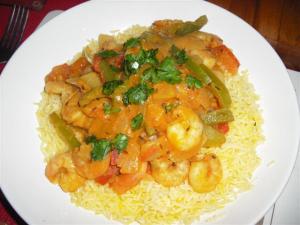It seems ages since I wrote a blog post, what with the house move to a whole new county, taking over our lives for the last 4 weeks!
Broadband has now finally been installed and there are fewer boxes in each room, allowing us to start cooking again properly and getting back in touch with the foodie community again. There are lots of people I will be catching up with over the next few weeks, plus learning about our new corner of the world and seeing what foodie goodies are available nearby.
One big bonus is that our new home has a big blackberry bush at the bottom of the garden, so thats me sorted for my wines, vinegars, coulis’ and compotes again this year.
This recipe below was one of the last dishes I cooked before we left our old house and was chosen as a blog post, as we needed to use up what we had left in our fridge and freezer. With all the fish we had left, this recipe seemed perfect to go with the Very lazy Ginger we had been sent!
Contrary to general belief, Korma is not a dish but one of techniques used in Indian cooking. This Fish Korma is easy to cook and has an irresistable aroma and taste.
Source: Curry Bible – Mridula Baljekar
Serves 2-4
Ingredients:
700g/1lb 9oz Fish fillets cut into large pieces (we used Salmon and Monkfish)
1 tbsp Lemon juice
1 tsp Salt
55g/2oz Raw unsalted Cashews
3 tbsp Olive Oil
5cm/2in Cinnamon Stick
4 Green Cardamom Pods, bruised
2 Cloves
1 Large Onion, finely chopped
1-2 Fresh Green Chillies, chopped
2 tsp Ginger Purée
2 tsp Garlic Purée
150ml/5fl oz Single Cream
55g/2oz Whole Milk Natural Yoghurt
¼ tsp Ground Turmeric
½ tsp Sugar
1 Place the fish on a large plate and rub in the lemon juice and ½ tsp of the salt. Set aside for 20 minutes.
2 Soak the cashews in boilng water for 15 minutes.
3 Heat the oil in a large pan over a low heat and add the cinnamon, cardamom and cloves. Let it all sizzle for 30-40 seconds.
4 Add the onion, chillies, ginger and garlic purées. Increase the heat slightly and cook, stirring frequently for 9-10 minutes, until the onion is soft.
5 Drain the cashews and purée them with the cream and yoghurt.
6 Stir the turmeric into the onion mixture and add the puréed ingredients, the remaining salt and sugar.
7 Mix thoroughly and arrange the fish in the sauce in a single layer. Bring to a slow simmer, cover the pan and cook for 5 minutes. Remove the lid and shake the pan gently from side to side.
8 Spoon some of the sauce over the pieces of fish, re-cover and cook for a further 3-4 minutes.
Serve with Indian Bread or Basmati Rice.
Enjoy!



















































